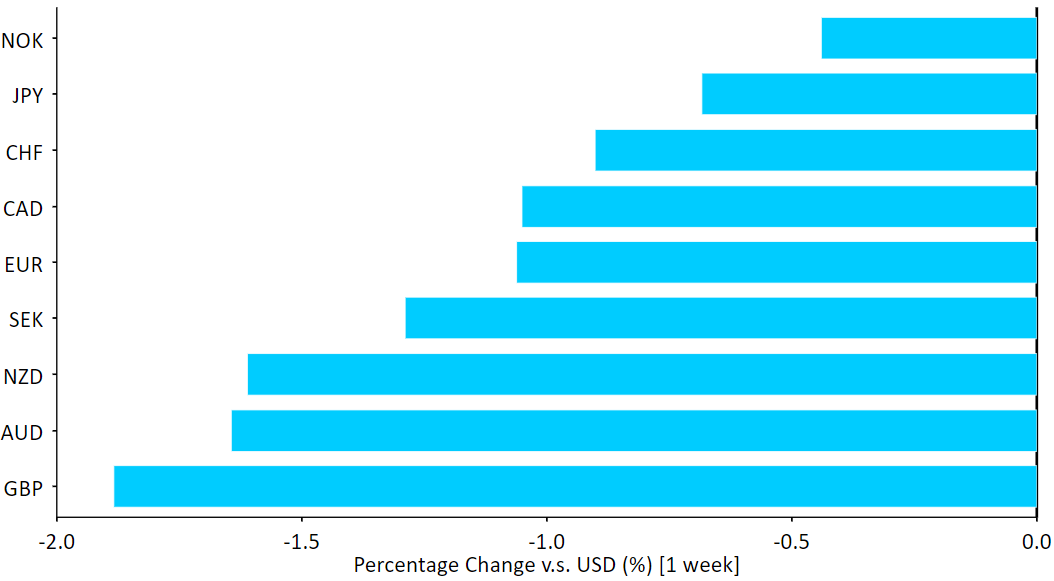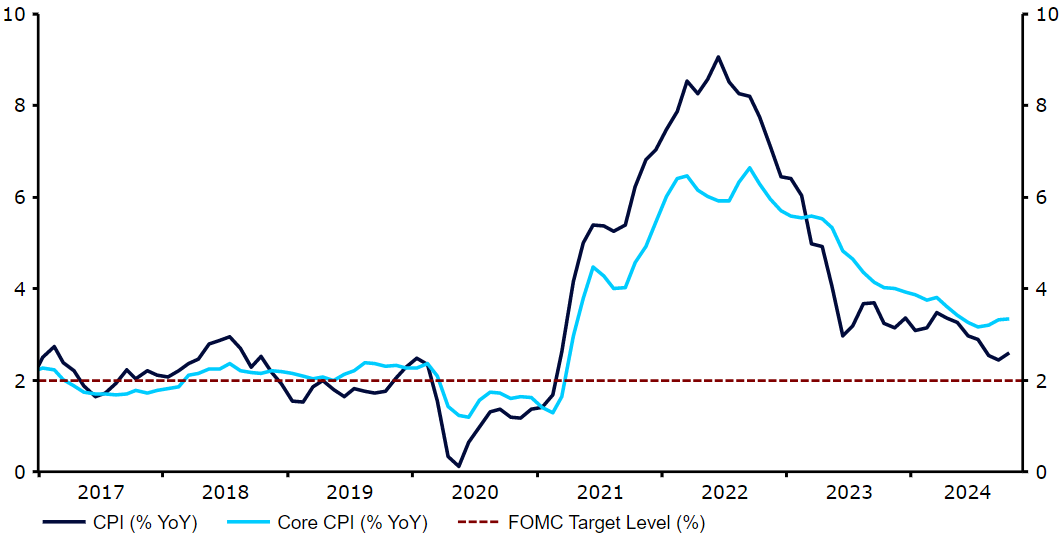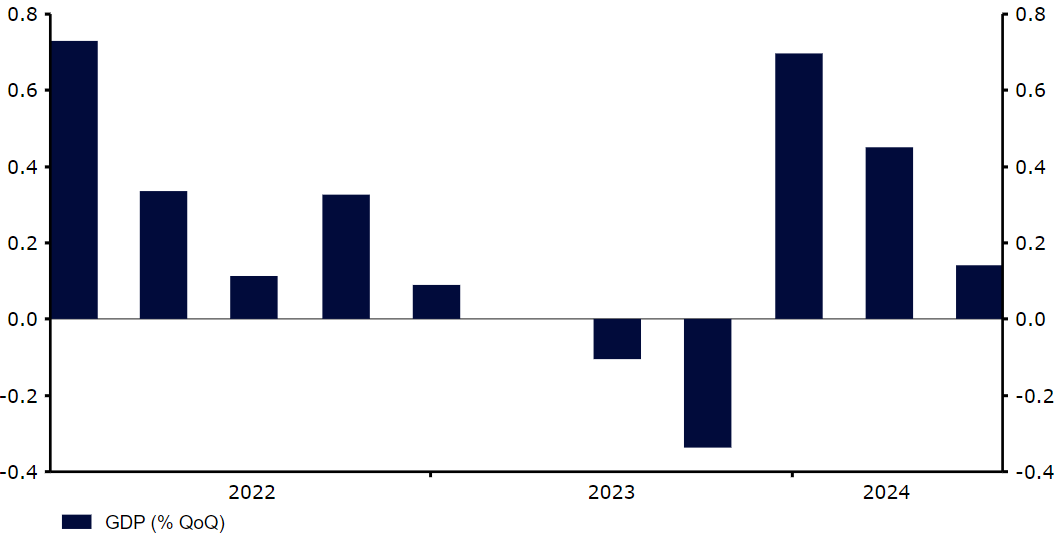Dollar rallies on as inflation fears in the US take hold
There were divergences in the so-called Trump trade last week.
FX Market Updates
There were divergences in the so-called Trump trade last week.Prospects for inflationary policy and higher Federal Reserve rates once again sent Treasuries lower and the dollar higher, but stocks and most risk assets are finally starting to feel the sting of higher interest rates and fell throughout the week. Almost every major currency lost ground to the greenback. The biggest loser of the week was the British pound, which was pummeled after third quarter growth data disappointed. On the positive side, the Mexican and Chilean pesos managed to eke out a small rebound for the week.This week will be a busy one for the euro and sterling, as the flash PMIs of business activity for November will be released globally on Friday. In addition, October UK inflation will be released on Wednesday. The calendar is lighter in the US, and the focus will be on the bond market reaction to last week's hawkish Federal Reserve speeches. In the background, markets will look for clarification on the size and extent of the coming US tariffs, as well as announcements regarding Chinese stimulus measures to counteract their effect.Figure 1: G10 FX Performance Tracker [vs. USD] (1 week) Source: LSEG Datastream Date: 18/11/2024 USDA key speech by Federal Reserve chair Powell last week made it clear that a rate cut in December is not at all a foregone conclusion, and suggested that the extent and duration of the current cutting cycle need to be revised. Markets promptly did so, though the move higher in rates had already started after yet another inflation print that showed the core index growing at a 3-4% annualized rate for the third consecutive month.Figure 2: US Inflation Rate (2017 - 2024)
Source: LSEG Datastream Date: 18/11/2024 USDA key speech by Federal Reserve chair Powell last week made it clear that a rate cut in December is not at all a foregone conclusion, and suggested that the extent and duration of the current cutting cycle need to be revised. Markets promptly did so, though the move higher in rates had already started after yet another inflation print that showed the core index growing at a 3-4% annualized rate for the third consecutive month.Figure 2: US Inflation Rate (2017 - 2024) Source: LSEG Datastream Date: 18/11/2024Markets are now pricing in a 60% chance of a December cut from the Fed. This outcome could depend completely on the single CPI inflation report that will be released before the 18th December meeting date. At any rate, it is difficult to see the Fed bringing the rate significantly below 4% under the circumstances, given the expected inflationary impact of Trump's tariffs and tax cuts. EURThe euro continues to fall victim to the Trump trade, as US rates rise relentlessly, widening the gap with the Eurozone. The divergence between the projected paths of interest rates on each side of the Atlantic is getting starker. Markets are starting to doubt whether the Fed will cut rates at all in December, while pricing a meaningful chance of a 50 basis point cut out of the ECB at one of the next two meetings.The common currency appears to have found some sort of a floor around the 1.05 level. The sell off against the dollar has been pretty brutal, and current levels seem to already price in a lot of divergence in economic performance in favour of the US. A PMI number above 50, indicating that the Eurozone economy is still growing, however slowly, could puncture this narrative and offer at least some temporary support for the euro. GBPSterling had a difficult week, falling to the lowest level in four months. The general downward trend in European currencies was exacerbated in the pound's case by a weak third-quarter GDP report, which showed that the UK economy grew about half as much as expected and is hovering again near a stall level. Indeed, the economy actually contracted in September on a month-on-month basis, with the report suggesting that concerns leading up to the Labour Autumn Budget, which delivered a sizable hike to employer National Insurance contributions, weighed on business activity.Figure 3: UK GDP Growth Rate (2022 - 2024)
Source: LSEG Datastream Date: 18/11/2024Markets are now pricing in a 60% chance of a December cut from the Fed. This outcome could depend completely on the single CPI inflation report that will be released before the 18th December meeting date. At any rate, it is difficult to see the Fed bringing the rate significantly below 4% under the circumstances, given the expected inflationary impact of Trump's tariffs and tax cuts. EURThe euro continues to fall victim to the Trump trade, as US rates rise relentlessly, widening the gap with the Eurozone. The divergence between the projected paths of interest rates on each side of the Atlantic is getting starker. Markets are starting to doubt whether the Fed will cut rates at all in December, while pricing a meaningful chance of a 50 basis point cut out of the ECB at one of the next two meetings.The common currency appears to have found some sort of a floor around the 1.05 level. The sell off against the dollar has been pretty brutal, and current levels seem to already price in a lot of divergence in economic performance in favour of the US. A PMI number above 50, indicating that the Eurozone economy is still growing, however slowly, could puncture this narrative and offer at least some temporary support for the euro. GBPSterling had a difficult week, falling to the lowest level in four months. The general downward trend in European currencies was exacerbated in the pound's case by a weak third-quarter GDP report, which showed that the UK economy grew about half as much as expected and is hovering again near a stall level. Indeed, the economy actually contracted in September on a month-on-month basis, with the report suggesting that concerns leading up to the Labour Autumn Budget, which delivered a sizable hike to employer National Insurance contributions, weighed on business activity.Figure 3: UK GDP Growth Rate (2022 - 2024) Source: LSEG Datastream Date: 18/11/2024We think the market may have overreacted to the GDP news, which is a very lagging indicator, and that the economy is doing reasonably well. Further, goods exports to the US are relatively limited and US tariffs should be less of an issue than for the Eurozone. At any rate, the PMI numbers out Friday take on added importance after the disappointing growth news last week. RONIt was not a particularly benign week for Romania from a macroeconomic perspective. Unlike neighbouring Hungary, it could not boast any progress on the inflation front in October. The headline measure posted an uptick for the first time since June, rising at the fastest pace since February on a monthly basis (0.62%). Wage growth, one of the key pro-inflationary factors, remained consistently high and close to double digits in real terms. As if that was not enough, Q3 GDP growth surprised downwards, registering flat quarter-on-quarter growth and a rather modest 1.1% YoY.Figure 4: Romania GDP [QoQ, SA] (2021 - 2024)
Source: LSEG Datastream Date: 18/11/2024We think the market may have overreacted to the GDP news, which is a very lagging indicator, and that the economy is doing reasonably well. Further, goods exports to the US are relatively limited and US tariffs should be less of an issue than for the Eurozone. At any rate, the PMI numbers out Friday take on added importance after the disappointing growth news last week. RONIt was not a particularly benign week for Romania from a macroeconomic perspective. Unlike neighbouring Hungary, it could not boast any progress on the inflation front in October. The headline measure posted an uptick for the first time since June, rising at the fastest pace since February on a monthly basis (0.62%). Wage growth, one of the key pro-inflationary factors, remained consistently high and close to double digits in real terms. As if that was not enough, Q3 GDP growth surprised downwards, registering flat quarter-on-quarter growth and a rather modest 1.1% YoY.Figure 4: Romania GDP [QoQ, SA] (2021 - 2024)
 Source: LSEG Datastream Date: 18/11/2024 USDA key speech by Federal Reserve chair Powell last week made it clear that a rate cut in December is not at all a foregone conclusion, and suggested that the extent and duration of the current cutting cycle need to be revised. Markets promptly did so, though the move higher in rates had already started after yet another inflation print that showed the core index growing at a 3-4% annualized rate for the third consecutive month.Figure 2: US Inflation Rate (2017 - 2024)
Source: LSEG Datastream Date: 18/11/2024 USDA key speech by Federal Reserve chair Powell last week made it clear that a rate cut in December is not at all a foregone conclusion, and suggested that the extent and duration of the current cutting cycle need to be revised. Markets promptly did so, though the move higher in rates had already started after yet another inflation print that showed the core index growing at a 3-4% annualized rate for the third consecutive month.Figure 2: US Inflation Rate (2017 - 2024) Source: LSEG Datastream Date: 18/11/2024Markets are now pricing in a 60% chance of a December cut from the Fed. This outcome could depend completely on the single CPI inflation report that will be released before the 18th December meeting date. At any rate, it is difficult to see the Fed bringing the rate significantly below 4% under the circumstances, given the expected inflationary impact of Trump's tariffs and tax cuts. EURThe euro continues to fall victim to the Trump trade, as US rates rise relentlessly, widening the gap with the Eurozone. The divergence between the projected paths of interest rates on each side of the Atlantic is getting starker. Markets are starting to doubt whether the Fed will cut rates at all in December, while pricing a meaningful chance of a 50 basis point cut out of the ECB at one of the next two meetings.The common currency appears to have found some sort of a floor around the 1.05 level. The sell off against the dollar has been pretty brutal, and current levels seem to already price in a lot of divergence in economic performance in favour of the US. A PMI number above 50, indicating that the Eurozone economy is still growing, however slowly, could puncture this narrative and offer at least some temporary support for the euro. GBPSterling had a difficult week, falling to the lowest level in four months. The general downward trend in European currencies was exacerbated in the pound's case by a weak third-quarter GDP report, which showed that the UK economy grew about half as much as expected and is hovering again near a stall level. Indeed, the economy actually contracted in September on a month-on-month basis, with the report suggesting that concerns leading up to the Labour Autumn Budget, which delivered a sizable hike to employer National Insurance contributions, weighed on business activity.Figure 3: UK GDP Growth Rate (2022 - 2024)
Source: LSEG Datastream Date: 18/11/2024Markets are now pricing in a 60% chance of a December cut from the Fed. This outcome could depend completely on the single CPI inflation report that will be released before the 18th December meeting date. At any rate, it is difficult to see the Fed bringing the rate significantly below 4% under the circumstances, given the expected inflationary impact of Trump's tariffs and tax cuts. EURThe euro continues to fall victim to the Trump trade, as US rates rise relentlessly, widening the gap with the Eurozone. The divergence between the projected paths of interest rates on each side of the Atlantic is getting starker. Markets are starting to doubt whether the Fed will cut rates at all in December, while pricing a meaningful chance of a 50 basis point cut out of the ECB at one of the next two meetings.The common currency appears to have found some sort of a floor around the 1.05 level. The sell off against the dollar has been pretty brutal, and current levels seem to already price in a lot of divergence in economic performance in favour of the US. A PMI number above 50, indicating that the Eurozone economy is still growing, however slowly, could puncture this narrative and offer at least some temporary support for the euro. GBPSterling had a difficult week, falling to the lowest level in four months. The general downward trend in European currencies was exacerbated in the pound's case by a weak third-quarter GDP report, which showed that the UK economy grew about half as much as expected and is hovering again near a stall level. Indeed, the economy actually contracted in September on a month-on-month basis, with the report suggesting that concerns leading up to the Labour Autumn Budget, which delivered a sizable hike to employer National Insurance contributions, weighed on business activity.Figure 3: UK GDP Growth Rate (2022 - 2024) Source: LSEG Datastream Date: 18/11/2024We think the market may have overreacted to the GDP news, which is a very lagging indicator, and that the economy is doing reasonably well. Further, goods exports to the US are relatively limited and US tariffs should be less of an issue than for the Eurozone. At any rate, the PMI numbers out Friday take on added importance after the disappointing growth news last week. RONIt was not a particularly benign week for Romania from a macroeconomic perspective. Unlike neighbouring Hungary, it could not boast any progress on the inflation front in October. The headline measure posted an uptick for the first time since June, rising at the fastest pace since February on a monthly basis (0.62%). Wage growth, one of the key pro-inflationary factors, remained consistently high and close to double digits in real terms. As if that was not enough, Q3 GDP growth surprised downwards, registering flat quarter-on-quarter growth and a rather modest 1.1% YoY.Figure 4: Romania GDP [QoQ, SA] (2021 - 2024)
Source: LSEG Datastream Date: 18/11/2024We think the market may have overreacted to the GDP news, which is a very lagging indicator, and that the economy is doing reasonably well. Further, goods exports to the US are relatively limited and US tariffs should be less of an issue than for the Eurozone. At any rate, the PMI numbers out Friday take on added importance after the disappointing growth news last week. RONIt was not a particularly benign week for Romania from a macroeconomic perspective. Unlike neighbouring Hungary, it could not boast any progress on the inflation front in October. The headline measure posted an uptick for the first time since June, rising at the fastest pace since February on a monthly basis (0.62%). Wage growth, one of the key pro-inflationary factors, remained consistently high and close to double digits in real terms. As if that was not enough, Q3 GDP growth surprised downwards, registering flat quarter-on-quarter growth and a rather modest 1.1% YoY.Figure 4: Romania GDP [QoQ, SA] (2021 - 2024)




